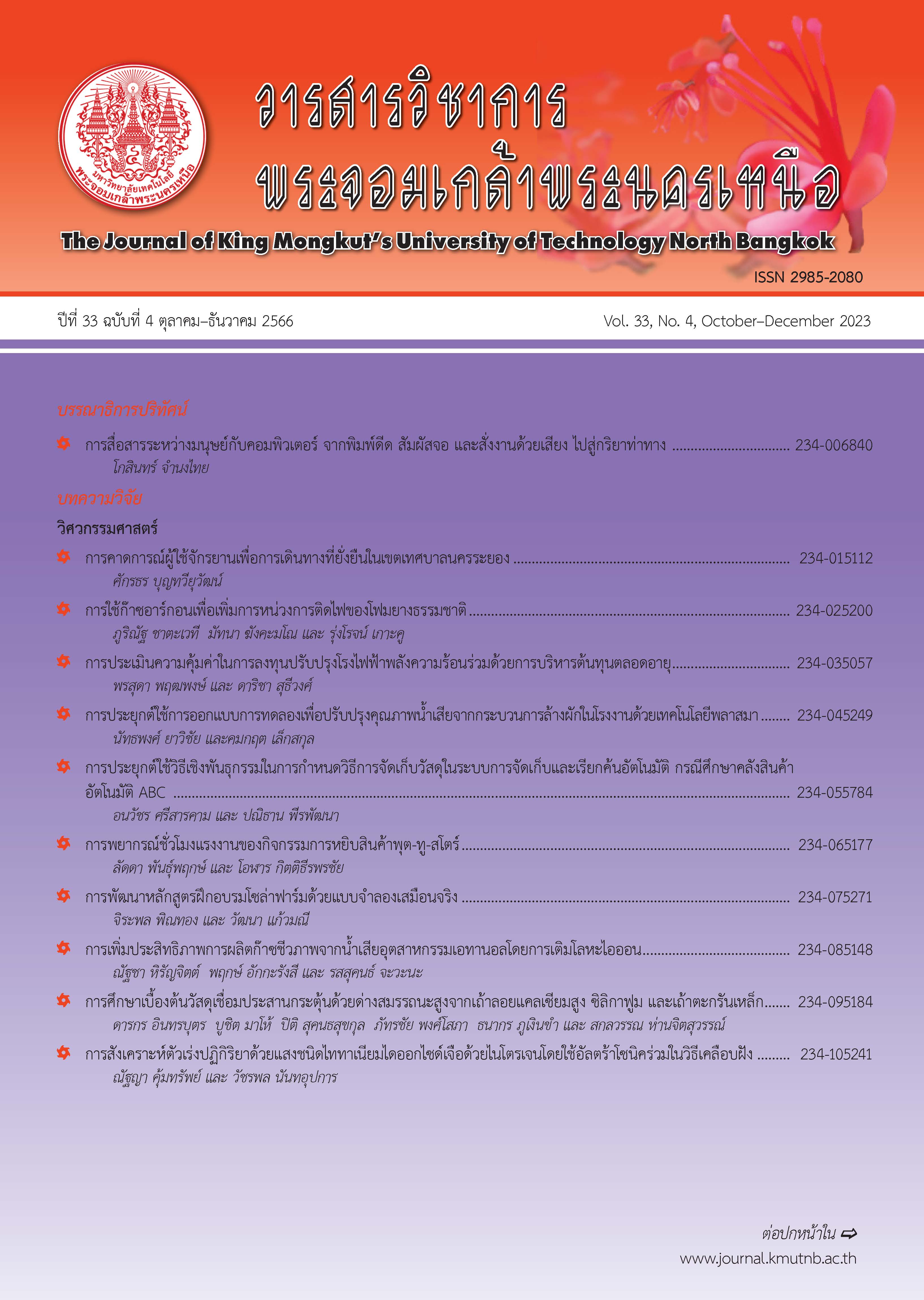การศึกษาการเปลี่ยนแปลงค่าความเป็นกรด-ด่างของข้าวและหาสภาวะที่เหมาะสมของสารละลายอินดิเคเตอร์ผสมสำหรับพัฒนาชุดตรวจอายุการเก็บข้าวอย่างง่าย
Main Article Content
บทคัดย่อ
เมล็ดข้าวมีการเปลี่ยนแปลงคุณสมบัติทางเคมีกายภาพตลอดระยะเวลาเก็บรักษา ส่งผลต่อคุณสมบัติการหุงต้มและการบริโภค งานวิจัยนี้มีวัตถุประสงค์เพื่อศึกษาการเปลี่ยนแปลงความเป็นกรด-ด่างของข้าวที่อายุการเก็บแตกต่างกันและหาสภาวะที่เหมาะสมของสารละลายอินดิเคเตอร์ผสมระหว่าง Methyl Red และ Bromothymol Blue เพื่อพัฒนาชุดตรวจสอบอายุของข้าวอย่างง่าย ตัวอย่างข้าวที่ใช้ คือ กข. 6 ขาวดอกมะลิ 105 และพิษณุโลก 2 ที่เก็บ 0–12 เดือน ที่อุณหภูมิห้องพบว่า ข้าวที่อายุการเก็บรักษาเพิ่มขึ้น จะมีค่าความเป็นกรด-ด่างลดลง โดยค่าความเป็นกรด-ด่างของข้าว กข. 6 ข้าวขาวดอกมะลิ 105 และข้าวพิษณุโลก 2 ลดลงจาก 6.82 เป็น 6.45 จาก 7.09 เป็น 6.45 และจาก 7.03 เป็น 6.49 ตามลำดับ สีของสารละลายอินดิเคเตอร์ผสมจะเปลี่ยนแปลงตามค่าความเป็นกรด-ด่างของสารละลายฟอสเฟตบัฟเฟอร์ (ช่วง 5.8–7.2) สภาวะที่เหมาะสมที่เห็นความแตกต่างของสีชัดเจนที่สุดในช่วงค่าความเป็นกรด-ด่าง 5.8–7.2 อัตราส่วนของสารละลายระหว่าง Methyl Red และ Bromothymol Blue คือ อัตราส่วน 60 : 40 เมื่อนำไปทดสอบกับข้าวที่มีอายุแตกต่างกันพบว่า สารละลายอินดิเคเตอร์ผสมเปลี่ยนจากสีเขียวเป็นสีเหลืองและสีส้มตามอายุการเก็บของข้าวที่มากขึ้น สามารถพัฒนาเป็นชุดตรวจสอบอายุการเก็บของข้าวอย่างง่ายได้ สามารถแก้ปัญหาการปลอมปนของข้าวได้
Article Details

อนุญาตภายใต้เงื่อนไข Creative Commons Attribution-NonCommercial-NoDerivatives 4.0 International License.
บทความที่ลงตีพิมพ์เป็นข้อคิดเห็นของผู้เขียนเท่านั้น
ผู้เขียนจะต้องเป็นผู้รับผิดชอบต่อผลทางกฎหมายใดๆ ที่อาจเกิดขึ้นจากบทความนั้น
เอกสารอ้างอิง
Department of International Trade Promotion, Ministry of Commerce (2021, February). Fact sheet of rice at 2020 [Online]. (in Thai). Available: https://www.ditp.go.th/ditp_web61/article_ sub_view.php?filename=contents_attach/730 242/730242.pdf&title=730242&cate=456&d=0
M. Chiawwet, “Aging of paddy using fluidized bed drying followed by tempering,” M.S. thesis, School of Energy and Materials ,Energy Technology, King Mongkut’s University of Technology Thonburi, Bangkok, 2005 (in Thai).
L. Wiset, “Effect of storage temperature and time on lipid content and physico-chemical properties of brown rice cv Khao Dawk Mali 105,” M.S. thesis, Graduate School, King Mongkut’s University of Technology Thonburi, Bangkok, 2000 (in Thai).
P. Jiatrakul. “Chilled storage bin for rice cv. Khao Dawk Mali 105,” M.S. thesis, Graduate School, Chiang Mai University, Chiang Mai, 2005 (in Thai).
W. Chinsuwan and P. Wannacharee, “Accelerated aging of hommail paddy by drying in sealed container,” KKU Engineering Journal, vol. 29, no. 1–2, pp. 131–146, 2002 (in Thai).
K. Wasantiwong, P. Wanitchang, P. Chanchareon, A. Imsil, J. Wanitchang and S. Kaewkrajang, “Quality changing of Khao Dawk Mali 105 varity by solar heart trement,” SDU Research Journal, vol. 5, no.2, pp. 27–36, 2012 (in Thai).
S. Preetong, “The study of factory affecting paddy drying process using the design of experiment,” M.Eng thsis, Industrial Engineering, Graduate School, Burapha University, Chonburi, 2016 (in Thai).
C. E. Park, Y. S. Kim, K. J. Park, and B. K. Kim, “Changes in physicochemical characteristics of rice during storage at different temperatures,” Journal of Stored Products Research, vol. 48, pp. 25–29, 2012.
N. Dalai, “Storage and hydrothermal treatments on physical and chemical properties of milled rice and flour,” M.S. thsis, School of Food Technology, Suranaree University of Technology, Nakhon Ratchasima, 2010 (in Thai).
Z. U. Rehman, “Storage effects on nutritional quality of commonly consumed cereals,” Journal of Food Chemistry, vol. 95, pp. 53–57, 2006.
K. Srikaeo and U. Panya, “Efficiencies of chemical techniques for rice grain freshness analysis,” Rice Science, vol. 20, no. 20, pp. 292–297, 2013.
R. J. Hsu and S. Lu, “Validation of the dye colour chart method for pH determination of rice grains,” Quality Assurance and Safety of Crops and Foods, vol. 5, no. 1, pp. 63–69, 2013.
C. Kumagai, Y. Hagiwara, T. Yamamoto, and K. Akiyama, “Detecting old rice,” The Journal of Brewing Society of Japan, pp. 733–736, 1978.
R. M. Villareal, A. P. Resurreccion, L. B. Suzuki, and B. O. Juliano, “Changes in physicochemical properties ofrice during storage,” Starch/ Starke, vol. 28, no. 3, pp. 89–94, 1976.
Z. Zhou, K. Robards, S. Helliwell, and C. Blanchard, “Ageing of stored rice: Changes in chemical and physical attributes,” Journal of Cereal Science, vol. 35, pp. 65–78, 2002.
N. S. Sodhi, N. Singh, M. Arora, and J. Singh, “Changes in physicochemical, thermal, cooking and textural properties of rice during aging,” Journal of Food Processing and Preservation, vol. 27, no. 5, pp. 115–124, 2003.
K. Liu, Y. Li, F. Chen, and F. Yong, “Lipid oxidation of brown rice stored at different temperatures,” International Journal of Food Science and Technology, vol. 52, no. 1, pp. 188–195, 2017.
S. Armniiyphikul, Analytical chemistry, Phisanulok: Pibulsongkram Rajabhat University, 2010 (in Thai).
Office of rice Inspection committeeboard of trade of Thailand. (n.d.). Fresh-aged rice testing. [Online]. (in Thai). Available: https://www. riceinspection.com/copy-of-analysis2-1.

